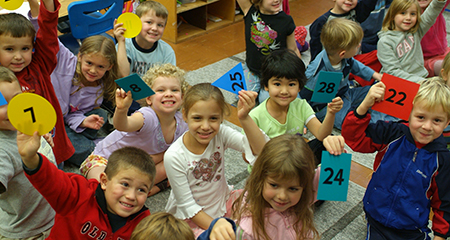
Bridges and Responsive Classroom—A Perfect Pair
Recently my school adopted the Responsive Classroom approach, which has been part of my teaching since 2001. What does it mean to be a Responsive Classroom school, and how does RC help me with Bridges math instruction?

1. The social and emotional curriculum is as important as the academic curriculum.
Responsive Classroom brings together academic and social-emotional learning through specific teaching practices and strategies. To foster cooperation and risk taking, my classroom must be a safe learning environment. Whether I’m introducing a new Number Corner workout, asking students to share their thinking with peers, or expecting them to work independently at Work Places, RC is behind our classroom success. Just as my instruction is very explicit in math or literacy, I am equally as clear with the rules and behavior expectations.
2. How children learn is as important as what they learn.
The Math Learning Center philosophy works hand-in-glove with Responsive Classroom. Both emphasize HOW students learn: through manipulatives, through mistakes, through interactions with peers, through self-discovery, through carefully sequenced problems. Students should be “doing” 70% of the time!
3. Great cognitive growth occurs through social interaction.
This tenet is interwoven throughout the MLC curriculum and the RC approach. Remember the three R’s? In Responsive Classroom, the three R’s represent the social-emotional curriculum: Reinforce, Remind, and Redirect. I use them often. I reinforce what students are doing correctly. I remind them what I expect them to do. And I redirect when they are unable to follow the rules. Students need to learn how to be successful in the classroom just as they need to learn how to read, write, and compute. This takes modeling, practice, and review. (And sometimes even more review!)
4. To be successful academically and socially, children need to learn a set of social and emotional skills that include cooperation, assertiveness, responsibility, empathy, and self-control.
My classroom has developed a repertoire of songs, chants, and games that build community through cooperation. And while having fun! Often these activities reinforce an academic skill. And always, they are a chance to stretch, move, and laugh. The Responsive Classroom website has links to books, blogs, and ideas for classroom elements such as Energizers, Morning Meeting, and the First Six Weeks of School. I hope Responsive Classroom will become part of your classroom!
For more information: www.responsiveclassroom.org
Marion is an MLC blog author and kindergarten teacher.